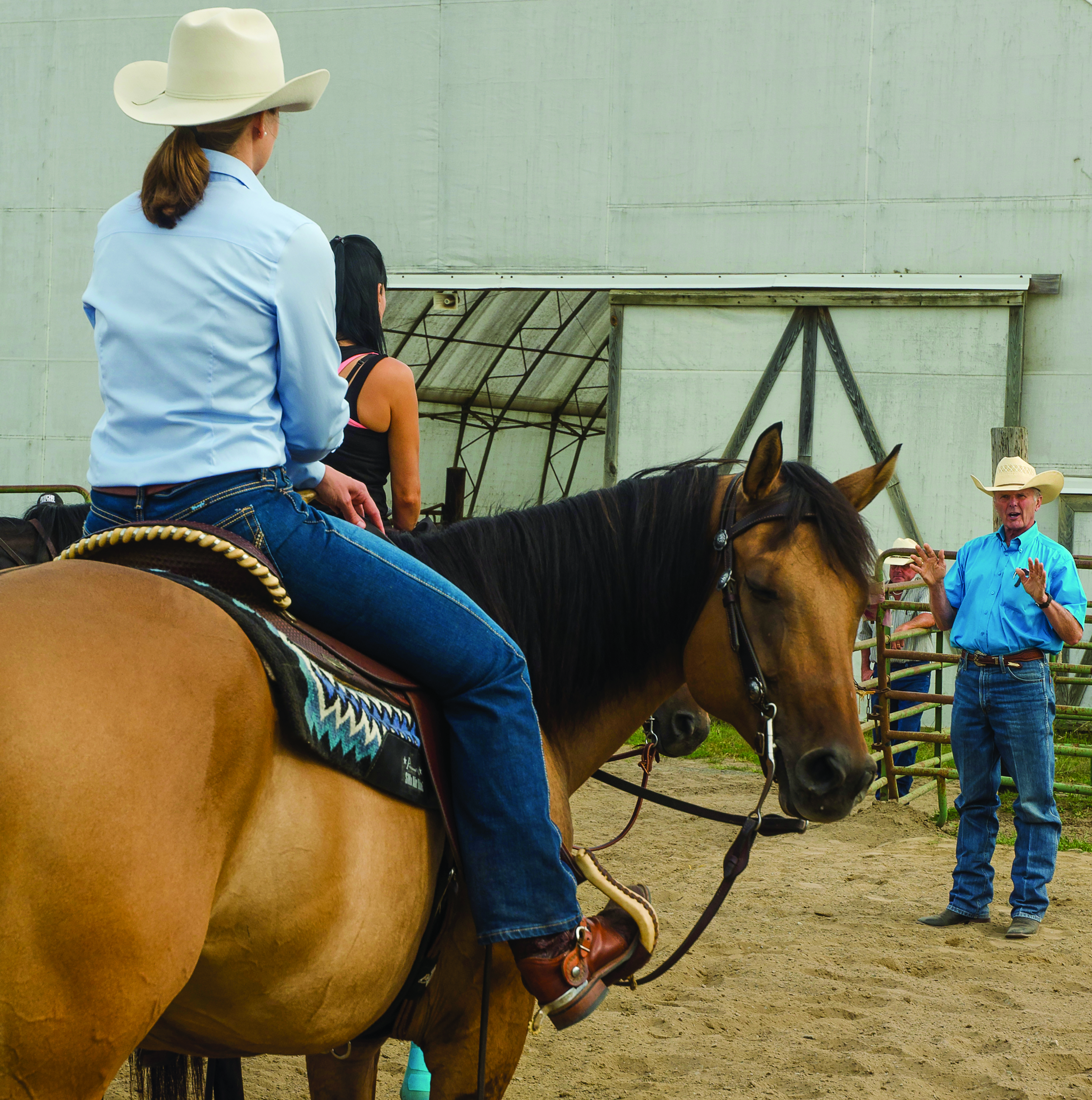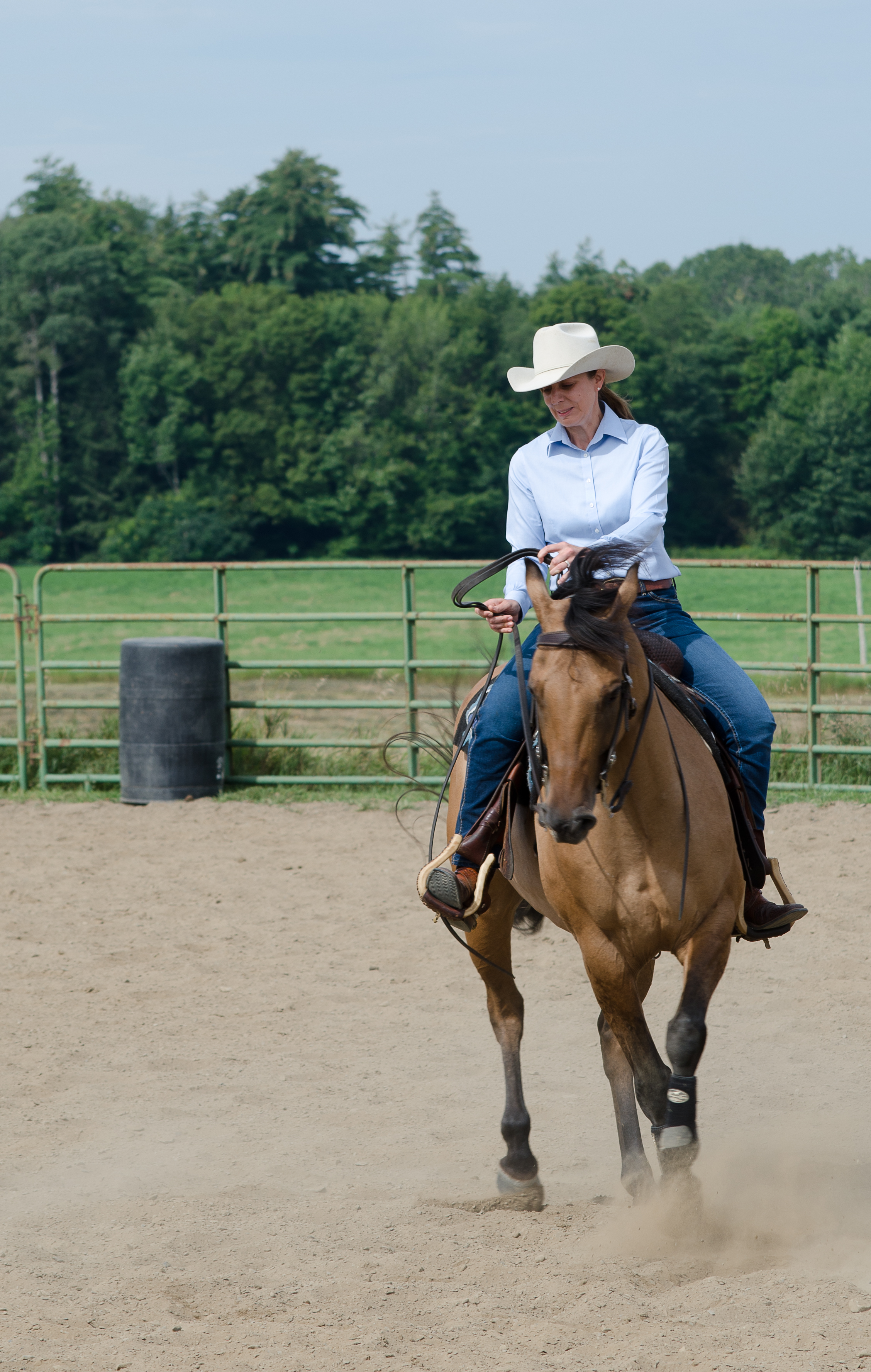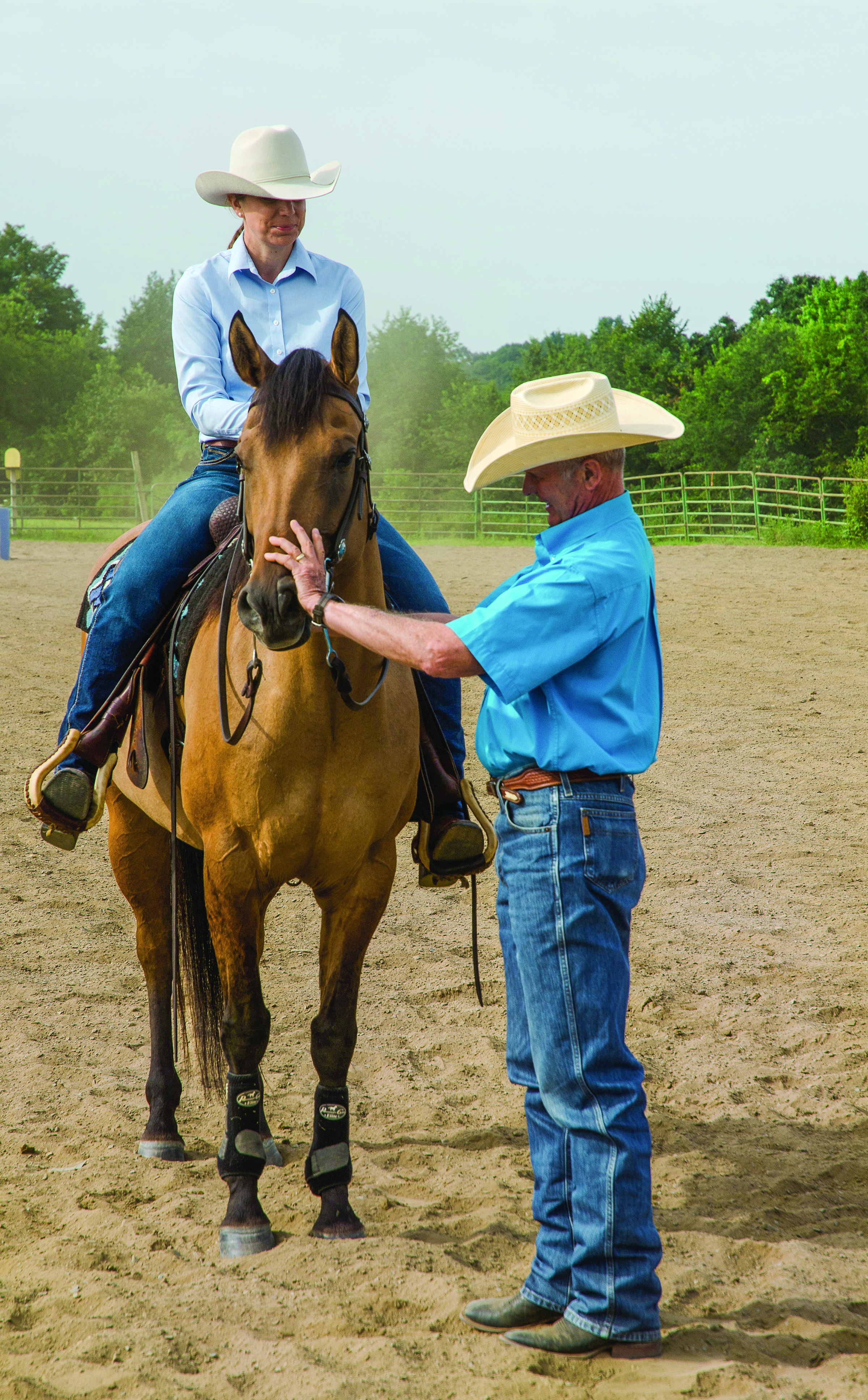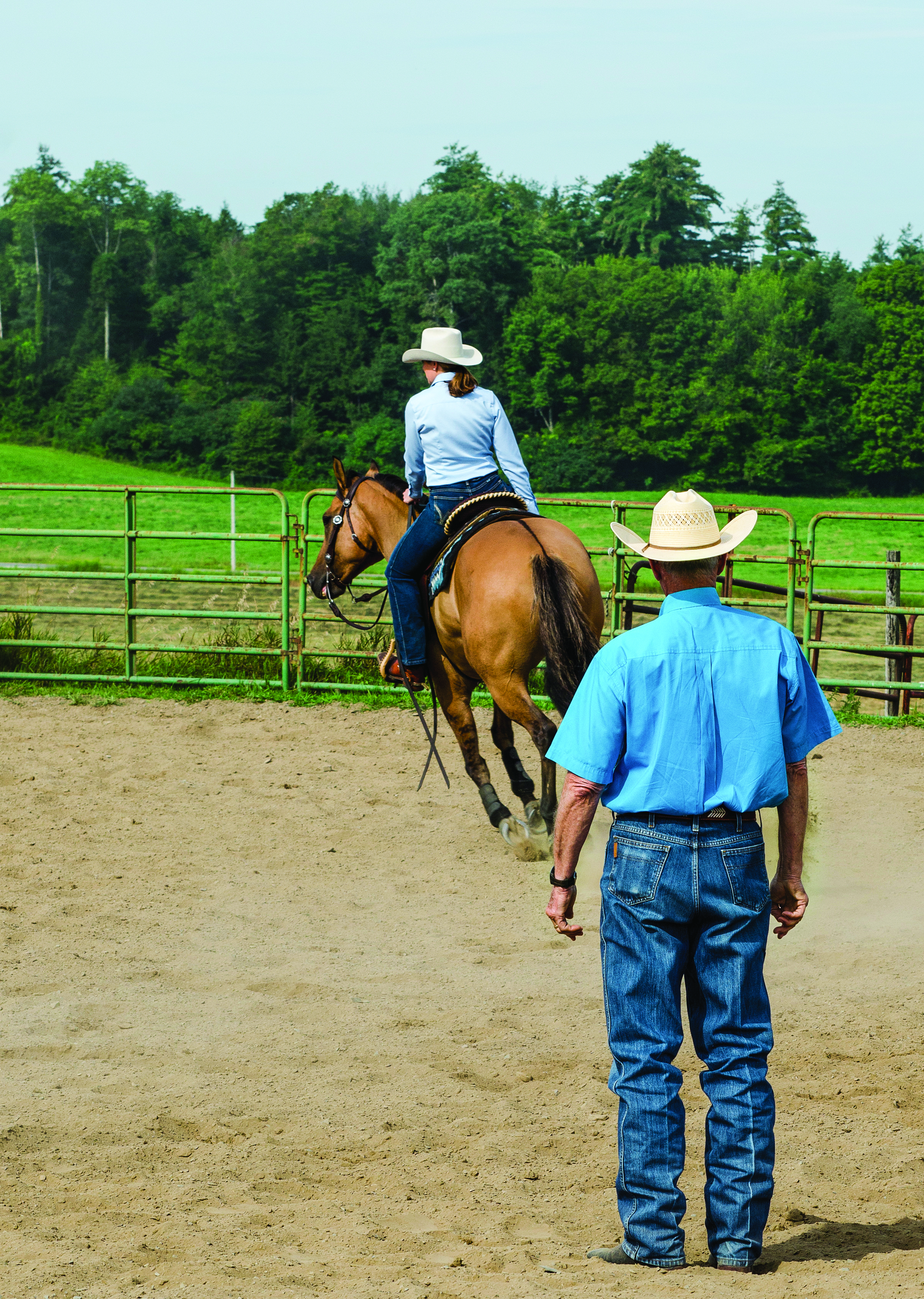As a lifelong Western rider, I’ve noticed Western performance events aren’t as plentiful in upstate New York as they are in other regions of the country. Because of that, access to nationally recognized reining, ranch horse, and cutting trainers is limited. So when I learned Texas-based reining trainer Joe Hayes was coming to town for a clinic, I couldn’t register fast enough!

Coincidentally, Hayes, who’s judged in 23 countries, was born in Greenwich, New York, a rural town not far from George Peters’ Win$um Ranch in Schuylerville, where I’ve taken lessons. It really is a small world, because Joe and George attended rival high schools fewer than 20 miles apart—then met at Cornell University as undergraduate agriculture education students.
I’ve ridden with George for five years now. He regularly talks about Joe, their adventures together, and his respect for Joe’s training program. Thus it was a no-brainer: I had to participate in this clinic! Here, I’ll share details about my horse and my clinic experience, in the hope of encouraging you to take the plunge and sign up for that clinic with someone you respect and admire.
Our Journey
Dusty Rose Thing (“Bella”) brought me back into horse ownership after a decade away. I bought her in 2012 as an untrained 4-year-old. That’s right—I broke all the rules about horse shopping. My decision was largely based on her gorgeous color. Her tawny coat, black points, and chocolate dorsal stripe sealed the deal. I didn’t have a plan for what I’d do with her, and it had been nearly 10 years since I’d owned and ridden an untrained horse. Yikes.
Our first two-and-a-half years were frustrating, and I almost sold her. But once I found George to help us, we progressed. I’m happy to report I now have a willing and handy ranch horse. We regularly compete in American Ranch Horse Association shows and hope to add American Quarter Horse Association ranch events to our competitive résumé in the future.

Our Goals
Before you write that check to attend a clinic, identify what you want to accomplish. One of the several goals I have for Bella is improving our performance in the reining classes at ARHA shows. Bella guides well, willingly handles speed transitions, and loves to stop. But our spins and rollbacks need serious help. Identifying these as my weak spots wasn’t easy to admit, but it enabled me to tell Joe precisely where I needed to improve. (Little did I know I’d need improvement elsewhere before we could tackle my self-identified problem spots!)
With a goal set, I next needed realistic expectations. Bella and I weren’t going to be suddenly spinning and rolling back like reining champs. I needed to recognize what level of improvement was possible and realistically evaluate my horse’s capabilities. With those benchmarks in mind, I was confident in my expectations. Then I learned that to improve our execution of these advanced maneuvers, we’d first need to go back to basics. Joe didn’t have a button to push to miraculously fix our problem areas; we were going to have to work to achieve our goals, and I’d have to adjust my original expectations for the clinic.
Being Present
Joe delivered the most impactful lesson of the full-day clinic in the first five minutes. He said our job as riders is to pay attention to every step of the ride. And that goes no matter what. For most of us, riding happens at the end of a day, after work. I know by the time I get to the barn I’m exhausted, frazzled, or stressed from a day at the office. Bella, who spends her summer days in a stall lounging in front of a fan, is well-rested and ready to work.
When I stepped into the stirrup and swung my leg over to ride in the clinic, my mind was anywhere but focused on the first few steps Bella would take as she moved when I mounted. Joe pointed out that my mindset was encouraging Bella’s bad habits. Allowing her to step left instead of staying straight ahead while I mounted set the stage for moving even farther to the left. Without correction, stepping left an inch becomes a foot—then bleeds into half a circle on a reining pattern. Key insight: Bad habits are best stopped before they form.
At first, though, it seemed extreme to concentrate on that level of detail. I mean, could it really matter that much? But the more I thought about it, the more I realized Bella was determining the size and shape of our circles rather than following where I was guiding her. That’s kind of funny since the point of reining is that the horse is willingly guided—not taking control. Since the clinic, I’ve made a conscious effort to be more deliberate in paying attention and staying focused every second that I’m with my mare. And I’ve noticed a resulting difference in the symmetry of our maneuvers. With every show, I can evaluate our scorecard to see how I’m doing, which also keeps me focused on what we need to do to improve.
Embracing Intensity
Joe advised me to ride aggressively, but by that he didn’t mean assault with my spurs or pulling needlessly on Bella’s mouth. He simply wanted me to be less timid in my riding and cuing and have more confidence in Bella’s abilities. If he said it once during the 45 minutes of individualized instruction, he said it 50 times.

This was hard to hear. Early in our partnership, I didn’t trust Bella. She was difficult to handle and had a laundry list of intimidating antics. I’ve concentrated on becoming more confident in the saddle and have managed to “fake it until I make it.” I thought I was at least exuding confidence, if I didn’t actually possess it. To learn Joe immediately saw holes in my confidence was a reality check—one I needed in order to achieve my goals with Bella.
How important is confidence? About a week after the clinic, I spoke with a successful young rider who’d won both world and reserve world championship titles in boxing at the AQHYA World Show. In her first reserve finish, she missed the world title by a mere half-point. She believed that half-point difference came down to confidence. She set a goal for the 2017 show season to improve her poise in the arena, and it paid off with the world title.
That resonated. I don’t currently show at that high level, but if I want to improve our performance at any show, there’s more work to be done.
Dreaded Lead Changes
I hadn’t planned on focusing on lead changes at the clinic. Admittedly, it’s something I tend to push to the back of my mind. Bella executes simple changes quite elegantly, which is acceptable for the shows we’ve competed in. Her clean, relaxed simple changes haven’t cost us points and, in some cases, have added to our score.
But it was one of the first things Joe had on his mind for clinic participants. Honestly, I’m glad it was. I’ve always admired Western riding competitors who can change leads every few strides. I struggle with getting the timing to get one lead change, let alone several in a row. We progressed from not getting any change to a half a lead change. It was by no means pretty, but I was communicating more clearly with Bella and we started to make progress. We still have a lot of work to do to perfect this; we certainly didn’t get it that day, but it started to make more sense.
Spins and Rollbacks
We made little improvement in my chosen area of focus. Bella is sloppy with her hind feet. Instead of planting a pivot foot and crossing over in front, she lazily wanders around a pivot. Consequently, our scores on these two maneuvers suffer. But we spent less than 10 minutes working on these with Joe. Instead, he gave me two drills to work on at home.
At first, I was disappointed with the lack of progress on the two items I’d most wanted to improve. As time has passed, however, I’ve realized that by concentrating on confidence and being present in the moment, I’ve vastly improved my day-to-day riding routine, and hence have more success as I work toward improving these maneuvers. And in reality, I had unrealistic expectations for what we could accomplish in one day.

The Takeaway
The past five years of Bella’s training and subsequent showing haven’t always been easy. Competing at ranch horse shows is one way I’ve been able to measure our progress. The score cards provide a starting point for the maneuvers that need further improvement. However, riding with Joe for a day provided an opportunity to hear a judge’s point of view on the details that we need to refine for future success.
While there’s still much room for growth, I’d call the clinic a success. Receiving confirmation that some things were working, identifying what isn’t as far along as I’d thought, and finding new ways of thinking about our struggles provided perspective and has helped me set goals for future advancement.






